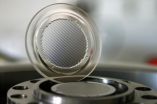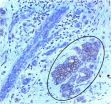(Press-News.org) Projectors are getting smaller and smaller. Now that pictures are available in digital format almost everywhere, we need projectors to beam giant photos and films onto walls. Projectors contain lenses that spread the light from the pixelated source in such a way as to illuminate the image area evenly. Until now, this was done using complicated arrays of lenses placed one behind the other. Recently, the same effect has been achieved using flat lens arrays made up of thousands of identical microlenses. This kind of array takes up much less space and does not need to be painstakingly assembled and aligned. To date it has only been possible to manufacture these lens arrays from plastic, but the light source in conventional projectors is hot enough to melt them. To get around this problem, Jan Edelmann and his team at the Fraunhofer Institute for Machine Tools and Forming Technology IWU in Chemnitz have developed a process for manufacturing lens arrays from glass, whereby the surface structure of the array is hot embossed into viscous glass at temperatures of between 600 and 900 degrees Celsius. "The main challenge is to keep the material exactly at the temperature where it is malleable but not yet molten," explains the project manager. "That is the only way to guarantee that components made from it will be within the prescribed tolerances to within a few micrometers."
The first step is to produce the forming die equipment, using tungsten carbide which is machined with ultra-precise grinders. "Of course, we have to take into account right from the beginning that the high temperatures will cause both the glass and the equipment to expand, but at different rates", says Edelmann. "So the die has to be a slightly different shape from the workpiece that we are looking to produce." Considering that 1700 absolutely identical square microlenses must fit into an area of just five square centimeters, it is not hard to imagine the level of precision that is required, and it is no surprise that it takes hours to produce the die. Once it is finished, the die is given a wear-resistant coating of precious metal.
During hot embossing, which takes place in a vacuum chamber, it is important for the glass and the equipment to be kept at a constant temperature until the workpiece has been ejected from the mold. The reason for this is that, during the cooling process, the glass shrinks more than the equipment. Tensions would otherwise arise and the lenses, only millimeters thick, might shatter. For ease of handling, the IWU researchers have given the workpiece an edge. Here, too, precision is of the utmost importance. Both stamping dies must be aligned exactly with one another, and there must be no slippage or distortion when they are pressed together.
The team from IWU has overcome all these problems and succeeded in producing arrays from high refraction glass that have extremely smooth surfaces and where alignment faults across all 1700 microlenses are smaller than 20 micrometers. "This is a world's first," says Edelmann happily. The process is suitable for use in mass production, and could bring the price of such components down to a tenth of what current lenses cost. Furthermore, arrays of this kind are not only important for projectors. They could also be used to broaden and homogenize laser beams, for example in industrial welding machines.
INFORMATION:
Hot embossing glass -- to the nearest micrometer
2010-12-23
ELSE PRESS RELEASES FROM THIS DATE:
Removal of hexavalent chromium from your drinking water
2010-12-23
The only way to learn if your water source has hexavalent chromium is to check with your public water supplier and request a water quality report, said NJIT Professor Taha Marhaba, a civil/environmental engineer. Most municipal or city engineers should be able to provide such a report upon request. Additional information specifically about hexavalent chromium levels may also be available.
"In general, hexavalent chromium can be found in either surface or groundwater sources and its source can be either natural or man-made industrial operations that have used chromium," ...
Drilling in the holy land
2010-12-23
About 50 miles from Bethlehem, a drilling project is determining the climate and earthquake activity of the Holy Land. Scientists from eight nations are examining the ground below the Dead Sea, by placing a borehole in this deepest basin in the world. The International Continental Scientific Drilling Program ICDP brings together research teams from Israel, Japan, Norway, Switzerland, the USA and Germany. Particularly noteworthy: Researchers from Jordan and Palestine are also involved.
Scientists and technicians of the GFZ German Research Centre for Geosciences have now ...
Researchers find gene that protects against dementia in high-risk individuals
2010-12-23
JACKSONVILLE, Fla. — Neuroscientists had assumed that a mutation in the progranulin gene, which makes the progranulin protein and supports brain neurons, was sufficient to produce a kind of dementia known as frontotemporal lobar degeneration (FTLD). But now an international team of scientists led by researchers at Mayo Clinic's campus in Florida have found another genetic factor they say appears to protect against the disorder in progranulin mutation carriers.
In an article published in the Dec. 22, 2010, issue of Neurology, the medical journal of the American Academy ...
Scripps Research scientist uncovers switch controlling protein production
2010-12-23
JUPITER, FL, December 22, 2010 – A scientist from the Florida campus of The Scripps Research Institute has discovered a molecular switch that controls the synthesis of ribosomes. Ribosomes are the large machineries inside all living cells that produce proteins, the basic working units of any cell. These new findings offer a novel target for potential treatments for a range of diseases, including cancer.
The study is published in the December 24, 2010 edition of the Journal of Molecular Biology.
The study identified the molecular switch, essentially formed by a small ...
Some cancer drugs may block cellular 'cross talk' but not kill cancer cells
2010-12-23
AURORA, Colo. (Dec. 22, 2010)—A class of drugs thought to kill cancer cells may in fact block "cross talk" between the cancer cell and normal immune cells, resulting in reduced cancer growth and spread—a discovery that could significantly alter the way cancer drugs are evaluated in the future.
Researchers at the University of Colorado Cancer Center demonstrated the discovery in bladder cancer, the fifth most common cancer in the United States. Bladder cancer will kill about 14,000 Americans this year, most of whom will die as a result of the disease's spread to other ...
Researchers train software to help monitor climate change
2010-12-23
University Park, Pa. -- A computer program that automatically analyzes mounds of satellite images and other data could help climate scientists keep track of complex, constantly changing environmental conditions, according to an international team of researchers.
"All of the data and information that is continually collected by satellites and sensors can cause tons of problems for scientists, who simply don't have the time to analyze every pixel of every satellite image," said James Wang, professor of information sciences and technology, Penn State. "Our goal has been ...
Measuring fatigue through the voice
2010-12-23
WASHINGTON, D.C., December 22, 2010 -- What can scientists learn from watching a group of people sitting around, chatting, playing movies, reading, and happily making new friends? Quite a lot, says University of Melbourne, Australia acoustician Adam Vogel, who carefully observed this sort of group in a fatigue management study he and his colleagues describe this month in The Journal of the Acoustical Society of America.
Their report shows the effects of sustained wakefulness on speech and describes a novel method to acoustically analyze the effects of fatigue on the central ...
AADR testifies to the FDA advisory panel on dental amalgam
2010-12-23
Gaithersburg, MD – On December 14-15, 2010, the U.S. Food and Drug Administration (FDA) convened an Advisory Panel to discuss several scientific issues that may affect the regulation of dental amalgam. At the conclusion of the hearing, the Panel voted to recommend that the FDA conduct further review of the material's safety.
The meeting comes on the heels of a July 2009 Final Rule (http://bit.ly/FDA2009FinalRule) from the FDA that reclassified dental mercury from a class I device to a class II device and designated special controls for dental amalgam, mercury and amalgam ...
Penn researchers identify potential target for breast cancer therapy
2010-12-23
PHILADELPHIA – Overexpression or hyperactivation of ErbB cell-surface receptors drives the growth of many breast cancers. Drugs, like Herceptin, that block the receptors' signals halt tumor progression in some patients. However, not all patients' tumors respond, with some becoming resistant over time. Different drugs that interfere with other steps in the signaling pathway may improve the response of patients, yet little is known about these molecules.
Now, Marcelo G. Kazanietz, PhD, professor of Pharmacology at the University of Pennsylvania School of Medicine and colleagues, ...
New annotated database sifts through mountains of sequencing data to find gene promoters
2010-12-23
Researchers at The Wistar Institute announce the release of an online tool that will help scientists find "gene promoters"—regions along a DNA strand that tell a cell's transcription machinery where to start reading in order to create a particular protein. The Mammalian Promoter Database (MPromDb) integrates the genome sequencing data generated at Wistar with publicly available data on human and mouse genomics. MPromDb pinpoints known promoters and predicts where new ones are likely to be found, the researchers say.
"Several complete genome sequences are available, including ...


